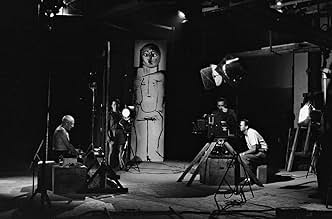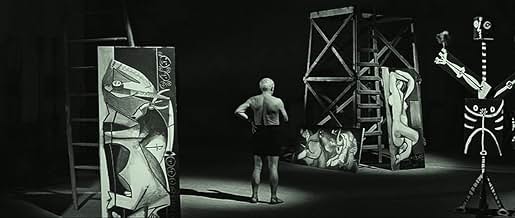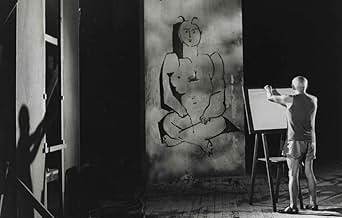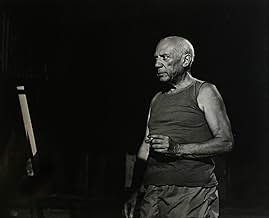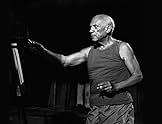IMDb-BEWERTUNG
7,5/10
2853
IHRE BEWERTUNG
Eine filmische Dokumentation über Pablo Picasso, wie er zahlreiche Leinwände für die Kamera bemalt, so dass wir an seinem kreativen Schaffensprozess teilhaben können.Eine filmische Dokumentation über Pablo Picasso, wie er zahlreiche Leinwände für die Kamera bemalt, so dass wir an seinem kreativen Schaffensprozess teilhaben können.Eine filmische Dokumentation über Pablo Picasso, wie er zahlreiche Leinwände für die Kamera bemalt, so dass wir an seinem kreativen Schaffensprozess teilhaben können.
- Regie
- Hauptbesetzung
- Auszeichnungen
- 1 Gewinn & 1 Nominierung insgesamt
Pablo Picasso
- Self
- (as Picasso)
Henri-Georges Clouzot
- Self
- (Nicht genannt)
Claude Renoir
- Self
- (Nicht genannt)
Empfohlene Bewertungen
One of the greatest filmmakers of France, Henri-Georges Clouzot, makes a film about his friend Pablo Picasso, perhaps the 20th Century's most renown artist. Clouzot begins with a proposition: if one were present at the conception of a great artistic masterpiece such as Mozart's Jupiter Symphony, and could peek inside the mind of the artist, what would one see? Fortunately, the visual art of painting offers a filmmaker that insight, and so Clouzot begins with Picasso in a dark room with white light directed at an empty canvas. The artist, like a bullfighter, confronts and ultimately displaces the empty space with drama and suspense. Clouzot takes a minimalist approach which chooses to focus on the art rather than the artist, and he achieves this objective by having Picasso sit on one side of a translucent canvas, and the camera on the other capturing only the ink or paint that has been administered, without the distraction or impediment of the artist - pure creation. A window into the mind of the artist! Twenty artworks are created in this manner, each being overlayed with the often suspenseful sounds of Georges Auric's excellent score. With THE MYSTERY OF PICASSO, art becomes exhilarating as one attempts to anticipate what Picasso will do next. "How will he resolve this problem?" Clouzot has created a priceless document for anyone seriously interested in art.
Henri-Georges Clouzot's The Mystery of Picasso starts by announcing that we will have the pleasure of entering the mind of Pablo Picasso, seeing how he gets his creative inspiration; the film promises us that the only way to do this is to watch Picasso's hand. Picasso paints on paper that the ink bleeds through, putting the camera on the other side of Picasso's canvas and watching the a reversed version painting appear in a seemingly magical way. It becomes clear early on that Clouzot is not wholeheartedly trying to show us how Picasso gets his inspiration; that is a mystery. Clouzot wants to capture the joy of painting. That's what makes this film so entertaining: watching bizarre, beautiful images appear out of nowhere. Sometimes Clouzot uses jump-cuts to show us the different phases of a work in progress at a rapid-fire velocity and then reverses the painting in the same jump-cut technique, deconstructing Picasso's. This is all scored to fiery jazz music. We also see Picasso while painting, as his painting is timed. (Picasso has a great screen presence). Clouzot is equally concerned with deconstructing Picasso's work to understand what makes this fast-working artist tick, showing how impossible that task is, and wowing us all the way through. As far as wowing goes, Clouzot did a pretty good job, with scenes that ranged from unforgettable to pleasantly surprising.
A-one-of-a-kind look at the artistic process, the unique art documentary captures the creativity itself. Two friends, the great painter and the great director, Pablo Picasso and Henri-George Clouzot decided to do what Goethe's Faust had dreamed about - to capture and to store forever the moment of beauty and inspiration. Picasso conceives, sketches, and paints twenty canvases before our eyes as the camera rolls. The film did not solve the mystery of Picasso who had said about himself, "When I was 9 years old, I could paint like Rafael; as an adult, all my life I tried to learn how to paint like a child" but it lets us to be the eye-witnesses of the amazing process - the birth of twenty works of art into existence. Twenty exiting moments the only Artist could live through are captured forever for us to enjoy again and again. Clouzot uses a specially designed transparent 'canvas' to provide an unobstructed view and different techniques including slow motion animation to let the main character, the invisible Picasso's brush speak for itself. The film is accompanied by exquisite music and gorgeous photography by Claude Renoir, grandson of impressionist painter Pierre-Auguste Renoir and nephew of Jean Renoir. The paintings created by Picasso in the film cannot be seen anywhere else. They were destroyed upon completion of the film. The French government has taken over the preservation of the original negative and has declared this truly unique and priceless documentary a national (and I would call it an international) treasure.
Criterion DVD also includes "Guernica", a short documentary directed in 1950 by Alain Resnais before any of his feature films. Picasso's "Guernica" is one of the most famous paintings of the 20th Century which was created by the artist in response to bombing and destroying the ancient Basque town of Guernica by German aviation on April 27 1937 during Spanish Civil War. The painting is a passionate protest against war as well as the fascinating work of art. Resnais' 13 minutes short film is based on paintings, drawings, and sculptures by Pablo Picasso from 1902 until 949 including "Guernica" and is set against the ode written by French lyrical poet Paul Éluard and recited by Jacques Pruvost and María Casarès. In his early short film, Resnais already uses his famous jump cuts and cross-fades. "Guernica" is a valuable feature which goes well together with the marvelous "The Mystery of Picasso" and adds to understanding one of the most prolific and mysterious Artists of the last century.
Criterion DVD also includes "Guernica", a short documentary directed in 1950 by Alain Resnais before any of his feature films. Picasso's "Guernica" is one of the most famous paintings of the 20th Century which was created by the artist in response to bombing and destroying the ancient Basque town of Guernica by German aviation on April 27 1937 during Spanish Civil War. The painting is a passionate protest against war as well as the fascinating work of art. Resnais' 13 minutes short film is based on paintings, drawings, and sculptures by Pablo Picasso from 1902 until 949 including "Guernica" and is set against the ode written by French lyrical poet Paul Éluard and recited by Jacques Pruvost and María Casarès. In his early short film, Resnais already uses his famous jump cuts and cross-fades. "Guernica" is a valuable feature which goes well together with the marvelous "The Mystery of Picasso" and adds to understanding one of the most prolific and mysterious Artists of the last century.
Director Henri-Georges Clouzot, best known in America for his expert thrillers (Diabolique, The Wages of Fear, Le Corbeau) captures a different kind of suspense in this astonishing documentary: can the viewer think faster than Picasso?
Of course not, don't be ridiculous. Pablo Picasso, seen here in his seventies, creates 20-odd paintings for the camera (a couple of them in real time), running rings around us as he goes. We see a line cross the screen, and then another, and then color spatters about; drawn on bleed-through paper the images come to us unmediated, like daydreams. Before we know it scenes take shape, populated by Picasso's stock company of matadors, clowns, leering old men, and towering, serene, bare-breasted women, their faces regally aloof.
This is Picasso Playful. Clouzot informs him at one point that there are only five minutes of film left and asks him what he wants to do. The old man replies "It'll be a surprise," quickly sketching a bouquet of roses and then taking it through acrobatic transformations, faking us out with deadpan glee. His buoyancy counterweights some of the director's more awkward touches, such as the portentous intro, some over-dramatic music, a few probably staged conversations... but who cares? This is dynamic, visual cinema-- in a sense, a great animated film.
Some of the earlier drawings are merely a master's doodles; others make your jaw drop with their absolute sureness of line. He'll send a stroke wriggling upward, graceful as a ribbon of smoke, and suddenly that wriggle is a bull with man tossed on its horns, and as the shapes gather and the colors erupt the thing becomes impossibly beautiful, a small perfection. Picasso returns to the image later, breaking out the oils, and here the film truly takes off. "I want to go deeper," Picasso tells Clouzot, and he does. We realize what we were missing in those first drawings: texture. The head of a goat coheres and takes on animal reality, the pigments bright as stained glass. Picasso ages it, makes it solid. What would be a major work for a lesser artist here is a throwaway, literally; the paintings were destroyed after filming. The least of them could have paid for my house.
In that intro Clouzot says something about "looking into the mind of the artist" or somesuch, but the title really says it all. At the beginning the artist saunters out shirtless from the studio's shadows. At the end he declares, "It is finished," and saunters back. What could possibly account for the existence of a Pablo Picasso remains a mystery untouched.
Of course not, don't be ridiculous. Pablo Picasso, seen here in his seventies, creates 20-odd paintings for the camera (a couple of them in real time), running rings around us as he goes. We see a line cross the screen, and then another, and then color spatters about; drawn on bleed-through paper the images come to us unmediated, like daydreams. Before we know it scenes take shape, populated by Picasso's stock company of matadors, clowns, leering old men, and towering, serene, bare-breasted women, their faces regally aloof.
This is Picasso Playful. Clouzot informs him at one point that there are only five minutes of film left and asks him what he wants to do. The old man replies "It'll be a surprise," quickly sketching a bouquet of roses and then taking it through acrobatic transformations, faking us out with deadpan glee. His buoyancy counterweights some of the director's more awkward touches, such as the portentous intro, some over-dramatic music, a few probably staged conversations... but who cares? This is dynamic, visual cinema-- in a sense, a great animated film.
Some of the earlier drawings are merely a master's doodles; others make your jaw drop with their absolute sureness of line. He'll send a stroke wriggling upward, graceful as a ribbon of smoke, and suddenly that wriggle is a bull with man tossed on its horns, and as the shapes gather and the colors erupt the thing becomes impossibly beautiful, a small perfection. Picasso returns to the image later, breaking out the oils, and here the film truly takes off. "I want to go deeper," Picasso tells Clouzot, and he does. We realize what we were missing in those first drawings: texture. The head of a goat coheres and takes on animal reality, the pigments bright as stained glass. Picasso ages it, makes it solid. What would be a major work for a lesser artist here is a throwaway, literally; the paintings were destroyed after filming. The least of them could have paid for my house.
In that intro Clouzot says something about "looking into the mind of the artist" or somesuch, but the title really says it all. At the beginning the artist saunters out shirtless from the studio's shadows. At the end he declares, "It is finished," and saunters back. What could possibly account for the existence of a Pablo Picasso remains a mystery untouched.
9sol-
A fascinating look at the creative process, filmed in a unique fashion, using a clever technique to capture Picasso's work as he is painting without his hand or his brush getting in the way. This method is actually shown and explained during a live action sequence in the middle. Although the film is mostly just a set of different Picasso paintings in action, interactions between the film's director and Picasso are added in, which not only decreases tedium from the at times monotonous paintwork, but it also makes it a whole lot more interesting, as it feels as if we are there with Clouzot and Picasso in a film studio. The material still becomes a tad repetitive and it tires before the film is over, but set to some great music and actually showing Picasso working through his creative process, this is remarkable, one-of-a-kind film-making and definitely worth checking out.
Wusstest du schon
- WissenswertesPablo Picasso is shown creating 20 drawings and paintings from start to finish. He allegedly destroyed these artworks afterwards so they would exist only in the film.
- Zitate
Pablo Picasso: I do not look for, I find!
- VerbindungenFeatured in Picasso (1985)
Top-Auswahl
Melde dich zum Bewerten an und greife auf die Watchlist für personalisierte Empfehlungen zu.
- How long is The Mystery of Picasso?Powered by Alexa
Details
- Erscheinungsdatum
- Herkunftsland
- Sprache
- Auch bekannt als
- The Mystery of Picasso
- Produktionsfirma
- Weitere beteiligte Unternehmen bei IMDbPro anzeigen
Box Office
- Bruttoertrag in den USA und Kanada
- 267.836 $
- Eröffnungswochenende in den USA und in Kanada
- 19.143 $
- 23. Feb. 1986
- Laufzeit
- 1 Std. 18 Min.(78 min)
- Farbe
Zu dieser Seite beitragen
Bearbeitung vorschlagen oder fehlenden Inhalt hinzufügen


